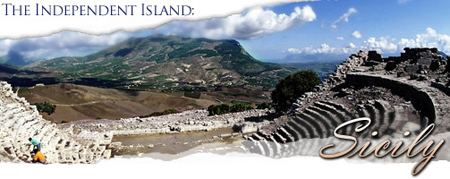|

Palermo, Sicily - A Holland America
Port
The
Sicilian province of Palermo serves
as a popular, yet quaint, port city
for any Mediterranean Cruise. The area,
known for its rich mosaics and decorative
palaces, is steeped in Italian history,
serving as great lessons for any traveler.
What
to See
If Palermo tours have an unofficial
starting point, Quattro Canti (Four
Corners) is a good bet. Although the
piazza at the intersection of via Maqueda
and Corso Vittorio Emanuele is not particularly
attractive, it is near most of the city's
monuments and attractive buildings.
When the crossroad was built in 1611,
it separated the area into four main
districts. Each section had its own
distinct dialect, that left little room
for intermingling. Historic residents
of the four districts viewed each other
with suspicion, if not open hostility.
When touring the area, visitors must
walk through Palermo's old districts.
For as long as anyone can remember,
there has always been a palace on the
hill above the old city. Although it's
history stretches further back, Palazzo
dei Normanni was renamed after the Normans
enlarged and refitted the magnificent
structure. In the 12th Century, the
building - known as the Royal Palace
- was one of Europe's finest. The structure's
interior is lined with mosaics. However,
its biggest treat awaits below in the
splendid Cappella Palatina. The nave,
covered with delicate mosaics and an
intricately carved ceiling, is called
the "finest religious jewel dreamt
of by human thought."
Many of Sicily's treasures are displayed
in Palermo's Archaelogical Museum, which
houses items from the Greek civilization,
as well as interesting Roman and Egyptian
carvings. The 15th-Century Palazzo Abatellis
is preserved as Galleria Regionale,
a collection of Arab-Norman art. The
two best-known works are the huge fresco
entitled "Triumph of Death"
and the Antonello of Messina's haunting
and beautiful Madonna, the "Annunciation."
The Palace is a popular Catalan-Gothic
showpiece for travelers.
Construction of Palmero's Norman cathedral,
Santa Maria Assunta (St. Mary of the
Assumption), begun in the 12th Century,
but it took several centuries to complete.
Some of the architecture appears out
of place since the building was modified
so many years later. The design did
incorporate Arabesque style, but the
lines were later lost. However, the
Norman foundation is still evident.
The interior of the building still contains
some of the original design. The Royal
Tombs serve as the resting places for
some of Sicily's most famous rulers
including Henry VI and Roger II, whose
body was brought from Cefalu. Handsome
and eccentric, King of Sicily and German
Emperor Frederick II died more than
700 years ago. However, mourners still
leave flowers at the resting site. Odo
of Bayeaux, William the Conqueror's
brother, is also buried at Palmero site.
The building's treasury includes illuminated
volumes, elegant gold jewelry and a
collection of gem-encrusted chalices
and crosses. The most famous is the
Crown of Constance, a 12th-Century sculptural
that elegantly blends Western, Byzantine
and Arabic styles.
History
Even with fewer than 750,000 people,
Palermo is Sicily's largest city and
main port. Ships laden with fresh produce
and manufactured goods ply the harbor.
Despite the fact the commodities have
changed, the commerce is nothing new
to Palmero. Normans especially favored
the port, and many of the most notable
buildings date back to that period.
However, Arab, Byzantine and Spanish
elements are also evident in local architecture.
Read
more on the Holland
America 10-Day Mediterranean Cruise.
|